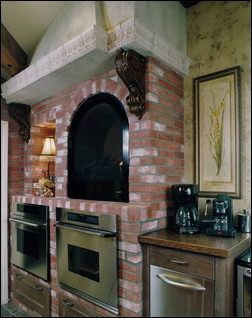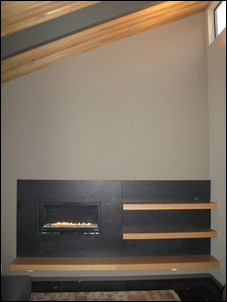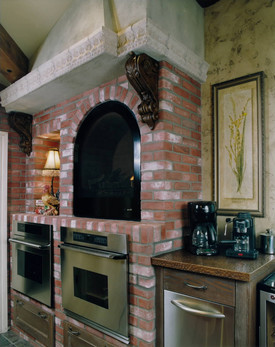There’s something soothing and timeless about natural stone. It’s both elegant
 Oklahoma City-based kitchen designer Karen Black-Sigler appreciates the texture that stone and brick veneer can bring to a room. She’s incorporated both into her own kitchen. Photo courtesy of A Karen Black Company. |
and rustic, making a room feel comfortable and grand at the same time. Plus, it’s a perfect fit with today’s homeowner who wants to connect his indoor and outdoor living spaces. And it resonates with the popular French country architectural style.
“If you look at any shelter magazine, you’ll see a lot of this specific design trend,” says Mark Fernandes, chairman of the Hollis, N.H.-based Natural Stone Council. “That architectural vernacular has a heavy use of stone in it.”
It’s also a commonly used material at spas, which possess a look and feel many people want to replicate at home.
For all these reasons, stone—whether it’s granite, flagstone, stacked stone, slate or sandstone—is high on many homeowners’ list of desired features. But full-sized stone has some drawbacks that make it unrealistic for many homeowners. Not only is the material expensive because of the labor involved to quarry it and the cost of shipping, the weight has to be supported structurally, which means added expense to shore up the house’s foundation and walls and the need to hire skilled stone masons for installation.
A More Affordable Alternative
That’s why stone veneers are such an attractive option. Stone veneers are thin slices of stone that can be applied over other materials, such as concrete block, brick, plywood or drywall.
 This contemporary fireplace incorporates a stone veneer with wood benches and shelves. Photo courtesy of Johnson Stone (www.johnsonstone.com). |
The technique has been available for years, and also is available for brick. What kept many people from using veneer was how to finish the end of the walls where it was applied. “When you went to do corners, you could see it was very thin,” Fernandes says. “People didn’t like that.” Recent technological advances, though, have provided the tools to saw veneer corners.
With all those factors, it’s hardly surprising that stone and brick veneer has gained in popularity in recent years. It’s a fraction of the thickness, the weight and cost. Yet they have the same look and feel as their full-sized counterparts. And in the case of stone veneer, it duplicates the uniqueness of full stone.
“One of the beauty marks of natural stone is the natural cleft face,” Fernandes explains. “That’s one of the things that can’t be mimicked by man-made products. With the thin stone [veneer], the stone will go from being four to eight-inches thick to one inch, and it still has that natural face.”
Great for Interior and Exterior
Russ Hemmis, host of HGTV’s 24 Hour Design, can attest to all those benefits. “Stone and brick veneers are a great way to give a fireplace, porch or fence columns a facelift,” he says. “I’ve used several different types and patterns and the results are always spectacular. Instead of demolishing and rebuilding, veneers can be installed right on top of the existing brick or stone work with minimal prep. These lightweight alternatives to traditional materials can also be installed over drywall as a kitchen backsplash or behind a wood-burning stove.”
Of course, stone veneer looks right at home on exteriors, where it’s used for everything from chimney surrounds, columns and porch steps to window casings and outdoor kitchens and fire pits. High-end Los Angeles-based custom builder
 BEFORE. Fireplace surrounds are one of the most common uses for stone veneer. As these photos show, it can dramatically change the look of a space. Photo courtesy of Russ Hemmis. |
and designer Janna Levenstein uses stone veneer on exteriors and interiors because it allows her to get the look of stone without extensive foundation work.
“I build structural walls all the time and slap stone on everything,” she says. That includes an exterior wall of her own house, which she veneered with a lustrous grey travertine marble and wrapped inside the garage.
A Focal Point for Any Room
While fireplace surrounds are the most common interior use of stone veneer, the material also provides a great look for an accent wall in a living room, family room, dining room or kitchen.
“You have a difficult time getting texture into most rooms,” says Oklahoma City-based interior designer Karen Black-Sigler. “Stone veneer is a wonderful way to do that. Artwork looks great hanging on natural stone when it’s properly lit.”
A certified kitchen designer, Black-Sigler uses stone and brick veneer extensively in kitchens. It can be used to frame a ventilation hood for a stunning centerpiece to the room. Brick veneer, when it’s properly sealed, makes a terrific backsplash that’s easy to clean. She has a brick veneer on the walls of her own kitchen and found several advantages over the real thing. Because it’s so much thinner, she got more usable space out of her kitchen, and a tile setter could set the material instead of having to call in a more expensive mason.
She has also used brick veneer to cover barrel ceilings. “You’ll see them most in a wine room or wine cellar,” she notes. “We’ve also done barrel ceilings in entryways and powder rooms.”
 AFTER. Fireplace surround with stone veneer. Photo courtesy of Russ Hemmis. |
Limitless Options
Chicago-based interior designer Ruth Mortensen from Susan Fredman & Associates says there’s literally no end to the possible applications for stone veneer.
“This is lightweight material,” she says. “You could do hallways, kitchens, family rooms—there are interesting applications everywhere. You could do a wall in a stairwell or put two stone pillars around a refrigerator; you could have some fun in a kitchen.”
Mortensen used it recently to redo a family room that had a fireplace clad in tile and mirrors, which she replaced with slate veneer. She also used it for the opposite wall, which has built-in niches for the stereo and plasma TV. It would have been impossible with full-sized stone.
“The whole thing is on a concrete slab,” she says. “Stone would be too heavy. Who knows what weight [the slab] would bear? The veneer looks very cool.”
Credit: Renovate Your World




























